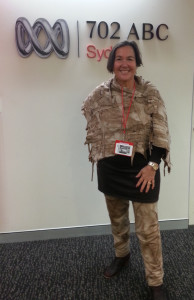A transformational shift during the past two decades in the way we source, use and discard our clothing has major social and environmental implications caused by increasing volumes, changing fibres and loss of repair skills.
These changes in clothing culture brought Jane Milburn of Textile Beat to Ku-Ring-Gai Council in Sydney on Saturday (June 25) to workshop more sustainable approaches, including reviving garments in your wardrobe. Jane was also interviewed by ABC 702’s Wendy Harmer about slow clothing, audio link below.
“Local councils report that about 4 percent of the household waste is textiles and most people know they can donate unwanted clothing for charitable recycling,” Ms Milburn said.
“Charities says about 15 percent of these donations are on-sold through op shops, 15 percent are ragged, 15 percent go to landfill and 55 percent are exported into the second-hand clothing trade.”
The global average annual consumption rose from 7 to 13 kg per person in two decades and two-thirds of new clothing is now made from synthetic fibres derived from petroleum, which research shows shed microplastic particles into the wastewater stream with every wash.
“In the same way we have become conscious of what we eat and want to know more about cooking and growing food, we are becoming more curious about what we wear – where clothes come from, the fibres they are made with, and where they go when we shed them,” she said.
Textile Beat has developed a Slow Clothing Manifesto to inspire change in the way we engage with clothing for the good of ourselves, society and the planet. The manifesto is based on 10 actions: think, natural, quality, local, care, few, make, adapt, revive and salvage.
“Instead of just following fashion, it is more ethical and sustainable to understand your needs and be engaged in the making process. That way you can dress with good conscience and in ways that are meaningful, unique and authentic,” she said.
“Textile Beat focuses on the substance, not just style, of the clothing we wear every day as protection and as a statement about who we are. Our aim is to conserve resources, foster ethical consumption and empower individuals with skills and ideas to take charge of their wardrobe needs.”
Ms Milburn advocates for a slow and sustainable clothing culture by engaging with local governments and teachers, and presenting workshops and talks around Australia.
